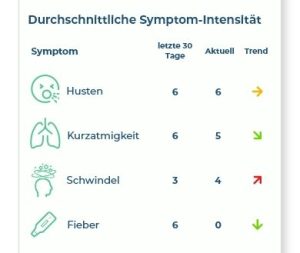Development and evaluation of a mobile application for monitoring symptoms in Long COVID patients to facilitate decision-making in primary healthcare
Aim and Research Question(s)
This study aimed to develop and evaluate a prototype of a mobile application for monitoring and visualizing Long COVID symptoms to support decision-making in primary healthcare. The study seeks to answer two main research questions: 1) How can symptoms and disease progression be visualized in an app to provide physicians with an overview of the patient's conditions and support their decision-making process? 2) How do physicians and/or public health experts rate the usability?
Background
Long COVID has become a notable public health issue, impacting a substantial number of individuals who have recovered from COVID-19. Primary healthcare physicians are the first point of contact for these patients, but the novelty of the disease as well as the complex and varied symptoms can pose significant challenges for accurate diagnosis and effective navigation of patients [1]. Self-monitoring has been recognized as a valuable approach to supporting individuals with Long COVID [1] and other chronic diseases [2].
Methods
The study adopts an iterative participatory mixed-methods design. User requirements were assessed through semi-structured interviews with three physicians/public health experts. A Design Thinking approach was utilized to develop an initial prototype, which was refined based on feedback from initial testing. The final prototype underwent a usability evaluation with five additional physicians/public health experts, including a Cognitive Walkthrough and a questionnaire based on the Technology Acceptance Model (TAM).
Results and Discussion
The prototype was designed to meet the specific needs in primary healthcare and incorporated essential information about symptom progression. Visualizations prioritized clarity and comprehension, utilizing symbols, bars, and percentages.
 The prototype was perceived as quite likely to be useful and extremely likely to be easy to use, as indicated by the TAM questionnaire results. All participants expressed their intention to use the app during primary assessments. Qualitative feedback also indicated positive perceptions, with suggestions for improvements in specific screens. Overall, the participants saw the potential to improve communication by asking more targeted questions and providing physicians with a deeper understanding of their patient's condition.
The prototype was perceived as quite likely to be useful and extremely likely to be easy to use, as indicated by the TAM questionnaire results. All participants expressed their intention to use the app during primary assessments. Qualitative feedback also indicated positive perceptions, with suggestions for improvements in specific screens. Overall, the participants saw the potential to improve communication by asking more targeted questions and providing physicians with a deeper understanding of their patient's condition.
Conclusion
This study highlights the potential of mobile applications in supporting the management of Long COVID and enhancing patient care in primary healthcare settings. However, the limited sample size restricts the generalizability of the findings. Future research should focus on assessing the impact of such applications on patient outcomes and explore their effectiveness and usability from the patient's perspective.
References
[1] Rabady, S., Altenberger, J., Brose, M., … Zwick, R. H. (2021). Leitlinie S1: Long COVID: Differenzialdiagnostik und Behandlungsstrategien. Wiener klinische Wochenschrift, 133 (Suppl 7), 237–278. [2] Wilde, M. H., & Garvin, S. (2007). A concept analysis of self-monitoring. Journal of advanced nursing, 57 (3), 339–350.
